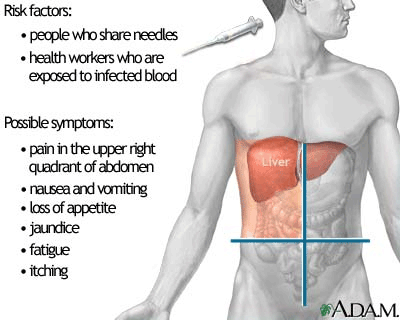
Although hepatitis C damages the liver, 80% of people with the disease do not have symptoms. in those whodo, symptoms may not appear for10-20 years, or even longer. Unfortunately, by the time symptoms appear, the damage may be very serious.
SARGODHA:
A Hepatitis outbreak has been reported in Sargodha and medical officials have said that nearly 60 per cent of the district is suffering from some form or other of the virus.
“The disease is spreading at an alarming rate,” said the district health officer (DHO). “We have begun an inspection of the local DHQ hospitals and dispensaries but many of the patients blame quacks,” he added.
Health official Raja Mubbashir said that in Qasba Matila every third person was suffering from Hepatitis C. “A lot of it has to do with the unsanitary hospital equipment being used and most of these people share their shaving razors etc,” he said. Mubbashir said that the district administration was working to curb the outbreak but the number of patients was increasing rapidly. “Hospitals do not even have enough space to accommodate the patients in some cases,” he added.
“The health department seems to be ignorant of what is happening. Many of the people don’t have access to clean drinking water and others are probably visiting doctors who are using unsterilised equipment,” a DHQ nurse Shireen said.
According to a local NGO, nearly four per cent of youths in the district are suffering from Hepatitis C. “The district authorities need to work harder to spread awareness about how the disease can be contracted so people are more cautious,” said an NGO worker Asad Khan.
The village’s basic health unit has no vaccination or test facilities and dozens of locals have protested against the district and health authorities over the past week. “Four of my children are suffering from Hepatitis C. They have been vomiting and have diarrhoea. Doctors told me they didn’t have enough vaccines,” said Shagufta Bibi, from Qasba Matila. “I know entire families that have contracted the disease. The water here is very dirty and it doesn’t make a difference how much or how often we boil it,” she said, adding “but the biggest problem is that barbers don’t use clean shaving utensils others in hospitals use unsterilized equipment,” she added.
Several residents in the districts blamed the spread of the disease on the increasing number of quacks practicing medicine in the district. “There are lots of hakeems and quacks here because the district hospitals and dispensaries are running out of vaccines.
These men claim they can cure the disease and they charge less so people flock to them,” said a resident Muhammad Virk.
Locals also said that the monsoon season and rains had caused deep pools of standing water and sewage in different areas of the district. “The filth is spreading infection and district authorities are slow to address these matters. we could easily have other epidemics break out because of this,” he added.
Causes and symptoms
Although hepatitis C damages the liver, 80% of people with the disease do not have symptoms. in those who do, symptoms may not appear for 10-20 years, or even longer. Even then, the symptoms usually come and go and are mild and vague. Unfortunately, by the time symptoms appear, the damage may be very serious. A minority of people have symptoms during the early acute phase of the infection. These symptoms typically develop 5-12 weeks after exposure to HCV. some people describe the symptoms as being flulike. The symptoms may last a few weeks or months and include nausea, vomiting, diarrhea, loss of appetite and fatigue.
HCV is not related to the other viruses that cause hepatitis. like the other hepatitis viruses, however, it is contagious. The hepatitis C virus is transmitted mainly by contact with blood or blood products.
Sharing of contaminated needles among IV drug users is the most common mode of transmission. using a needle to inject recreational drugs, even once several years ago, is a risk factor for hepatitis C. Transfusion with infected blood or blood products, hemodialysis, or transplantation of organs from infected donors was once a common mode of transmission butis now rare.
Published in The Express Tribune, August 4th, 2011.